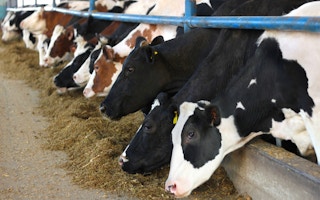Stand by for a new breed of farm animal – the low-methane cow. European scientists are collaborating in a bid to find a cow that makes the same milk, but manages to do so while emitting lower levels of natural gas from the ruminant stomach.
Methane is a fact of farm life: cows eat grass, hay and silage, and then proceed to digest it with help from an arsenal of stomach and gut microbes. But methane is also a potent greenhouse gas (GHG): weight for weight it is more than 20 times more potent than carbon dioxide over a century.
About a fifth of all GHG emissions from agriculture are directly released from the stomachs of the world’s cattle herds. And a consortium called RuminOmics has launched research into every aspect of animal husbandry in an attempt to lower the methane productivity while keeping up the dairy output.
Phil Garnsworthy is a dairy scientist at the University of Nottingham, UK, and one of the project partners. He reasons that cattle vary quite dramatically in the levels of methane from their stomachs, so it would be possible to imagine a dairy herd that produced the same volume of milk while reducing their gaseous discharges.
There are other factors: as every human knows too well, gas output is linked to diet. “It is possible to imagine cutting emissions from cattle by a fifth, using a combination approach in which you would breed from lower-emitting cattle as well as changing their diets”, said Professor Garnsworthy.
More profitable
Inheritance, too, may play a role. “There are three issues: diet, genetics and the microbiology of the cow’s rumen”, says Lorenzo Morelli of the Catholic University of the Sacred Heart in Piacenza, Italy. “We think that animal genetics may well influence their gut microbiology. However, this link has not been proved and we are still in the data collection phase.”
Most animal husbandry research has concentrated on raising animal productivity and fertility. But lower methane output could join the list of desired characteristics. There could even be a direct pay-off for the herdsmen.
“The methane is lost energy that could go into producing milk”, says Morelli. “So if we can find the right genetic mix, we can find cattle that are less polluting, more productive, and more profitable for the farmer.”
Methane is a short-lived gas: it stays in the atmosphere for about 10 years. Carbon dioxide – always the dominant greenhouse gas – is released in far greater quantities, and a molecule of carbon dioxide stays in the atmosphere for about 100 years.
Multiple gains
But the same volume of methane over a 20-year period will trap 70 times the heat that carbon dioxide retains, so any serious reduction in methane output could make a significant difference to the pace of climate change. Some scientists have argued that it would be better simply to reduce the herds, rather than their digestive output.
In December an international team argued in the journal Nature Climate Change that since methane was the second most abundant GHG, one of the most effective ways to cut output would be to reduce global populations of ruminant livestock – sheep, goats, camels and buffalo as well as cattle are all ruminants.
Globally, they argued, the numbers of ruminant livestock had risen by 50% in the last 50 years, and now about 3.6 billion animals were grazing on about one quarter of the Earth’s land area. Furthermore, a third of all arable land was used to grow feed for these animals.
“Cutting the number of ruminant livestock could have additional benefits for food security, human health and environmental conservation involving water quality, wildlife habitat and biodiversity”, said Peter Smith of the University of Aberdeen in Scotland, one of the authors.










